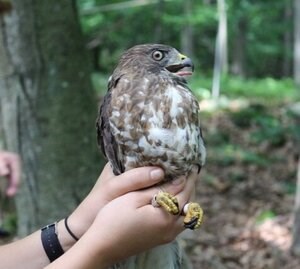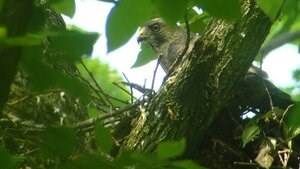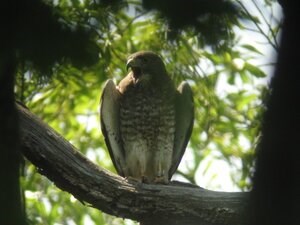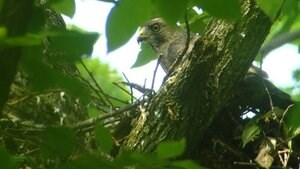The Broad-winged Hawks of Mountaineer Village
Posted on in In the Field by Holly Hartshorne, Volunteer

I became a volunteer in the Broad-winged Hawk Project during the spring and summer of 2014. I was out for my usual early morning walk, binoculars in hand, looking for spring migrants, when I heard a strange call from the woods nearby. I had heard it for the first time the previous week in this exact spot. I searched until I found the calling bird and was surprised to discover a broad-winged hawk perched in a tree not far from where I’d heard the sound. The call consisted of a few short, clipped notes of the same vocal tone as the more familiar broad-winged hawk whistle, the piercing call the bird is known for. I thought it odd to hear this chatter in the same place two weeks in a row. Searching the woods in hopes of finding the bird again, I got lucky. I arrived in time to watch him fly the small snake trapped in his talons up to a nearby tree limb, where he delivered it to a female. She accepted the gift, they copulated, and with their romance underway, a new one started for me as well.
Aware of the Broad-winged Hawk Project that Hawk Mountain had begun the year before, I shared my sighting with Dr. Laurie Goodrich, and she asked if I’d look for the nest. I accepted the challenge and became immersed in a new passion. That spring, I found the nest, and after many hours spent monitoring it, I became intimately involved with that broadwing pair. As summer elapsed, I watched as they raised and fledged two young. The Sanctuary team successfully trapped and banded the male broadwing, creatively named Orange-orange for the double orange plastic leg bands he was given that day.

Now, five years later, I’m still watching for the broadwings’ return, and what a spectacle it is each year, when the raptors first arrive back on their breeding turf. My couple likely meet up on the mountain rather than migrate together, and when they first reunite in spring, their joy is evident. I can say that as a non-scientist. Each year the joy and excitement is as great for me as it is for them.
Each year upon their return, I’m tasked with finding their nest. Since my pair has adopted nests more often than building from scratch, I start looking for potential structures in winter and note locations to check in spring. It’s always a race against time, trying to find their nest before full leaf-out occurs. The broadwings are highly skilled at choosing a nest that will be virtually concealed come summertime. My pair seems especially concerned with nest concealment rather than size or type of tree. After sometimes spending weeks chasing the broadwings around the area, what a great feeling it is to finally find the female sitting on a nest!
After finding the occupied nest, I leave the birds alone for a few weeks, taking a discreet peak every couple of days to ensure all is well. The more time they invest in a clutch, the less likely they are to abandon it. In my second season with the project, I found the female shaping a nest by adding sticks. On subsequent days, she appeared to be incubating. Thirteen days later it was clear she was gone. What happened to make her move? I’ll never know. Had she been looking for the most comfortable nest? In hindsight, I wonder, could this have been a completely different female? I scoured the premises and was lucky to find her on another nest later that day. Ever since, I’ve given the birds their privacy until hatching time nears.

With the nest discovered and the female three weeks into incubation, the next big challenge was determining if the broadwings were our banded birds. Unfortunately for me, Orange-orange had managed to remove those bright orange bands by the following spring, making identification difficult, and the metal USGS band he wears on his left leg is much harder to spot. I had the most luck pointing my scope at the nest in the last week before the eggs hatch. The male is most protective while the young are still in the nest. When he sees me, he becomes agitated, comes in close, and scolds me. That’s when I was able to see the band, and with luck, I got a picture.
How do I know OO has returned annually to raise a family with the Mama B? Truthfully, I don’t for sure, but by analyzing personality and behavioral clues, it’s a safe guess. When you spend enough time watching these creatures, you get to know them. I’m as certain as I can be that this pair have been together at least until last year.
While we were trapping at one nest the previous year, we found a second nest with two young broadwings only about 80 meters from the first. There was reason to wonder if OO was the male to both nests, for one day he chased me from the first nest and right out to the second nest, where he didn’t stop yelling at me until I left. It was something I was never able to confirm, but the question lingers. Could that be possible? In 2016, 2017, 2018 and again this year, I often saw or heard three broadwings together as soon as the birds arrived back. There may have been two pairs of birds nesting in close proximity so that they frequently clashed. The more you think you know, the more you learn; and the more you learn, the more questions arise.

By now I imagine the pair is used to my presence, and I hope they know I mean them no harm. After all, they have successfully raised five broods, ten young, in spite of me. Now, I almost feel accepted. Watching them mature over time has been fascinating.
Nest monitoring takes time and patience, sitting and waiting sometimes for hours for adults to appear with prey, but I can think of no better way to spend my spring times. Here on my broadwing stakeouts I have an excuse just to be and take it all in. If not for sitting so quietly at my post, I would have missed the fawn hidden by its mom, the beautiful gray fox, the yellow-billed cuckoo and other nesting songbirds around me, the heady scent of hawthorns and warm pine needles. For me, there is no better background music than the minor-key chorus of wood thrushes.
The young broadwings are on their own for only about a month before an internal urge summons them to the southern hemisphere. The journey is dangerous enough for experienced, adult hawks; how the young ones do it, inexperienced and hungry, I can’t imagine. It’s bittersweet when one day in August, their parenting mission complete, the adults disappear. The young spend a couple of weeks calling for their parents until they give up and move on, too. Another season with the broadwings comes to an end, and I wish them good luck on an incredible journey.
The broad-winged hawk is a forest raptor that nests throughout the northeast and northcentral United States and southern Canada. They arrive in Pennsylvania around the second week in April and immediately establish a territory, build a nest, and raise their young. Reclusive, secretive, and difficult to find in summer months, they gather in September in large flocks, or kettles, of hundreds or thousands of birds, on their migration south to wintering sites in Central and South America. Come fall migration, bird watchers and nature lovers head for hawk watches along mountain ridges and coastal points to witness one of the most spectacular migrations on earth.
Interested in learning more about this long-distance migrant, its nesting ecology, and its habitat needs, Hawk Mountain Sanctuary launched the Broad-winged Hawk Project in 2013. Although migration is heavily studied, ornithologists know little about habitat use, nesting and wintering behavior, and conservation threats. The project’s goal is to use satellite telemetry to learn more about conservation threats and habitat needs of this species year-round as well as to track broad-winged migration from season to season. This information will guide conservation efforts.